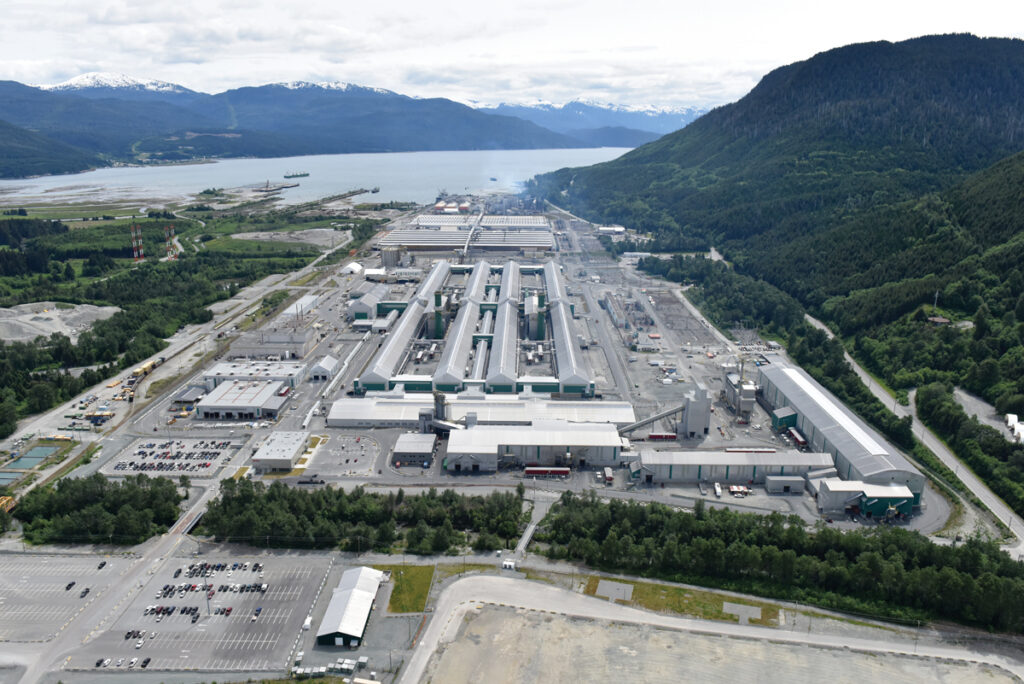Uneasy Lies the Coast
The relationship between Indigenous peoples and environmentalists has turned particularly sour along the B.C. coast, where project cancellations are leaving people without hope

The town of Kitimat, perched on the B.C. coast between the mountains and the ocean, began as a provincially sponsored industrial project in the 1950s. The government of the time invited the Aluminum Company of Canada, better known as Alcan, to build a hydro-electric generation station, an aluminum smelter, a transmission system and, to connect those assets, a 16-kilometre tunnel through Mount Dubose. The construction that followed resulted in the largest private-sector investment in the history of the country to that time.
For seven decades, that development drove the regional economy, and the town of Kitimat peaked with a population of more than 14,000 in the early 1980s. By 2016, that population was down to 6,400 as upgrades and expansions to the smelter languished amid public opposition. Now owned by global giant Rio Tinto Alcan, the smelter finally received a $5 billion upgrade in 2015. When the first ceremonial pour of molten metal was done in July of that year, the plant manager said the company was aiming for nothing less than another 60 years.
In recent years, Kitimat has become better known as the potential terminus of a number of proposed oil and gas pipelines, including Enbridge’s Northern Gateway and the Shell-led LNG Canada project. Those projects have been either shelved or cancelled in the face of fierce environmental opposition.
But there’s another Kitimat, too. Ten kilometres around the bay from the town site that grew up around the smelter and accompanying deep-water port is Kitamaat Village, the home community of the Haisla First Nation. The Haisla have used the surrounding territory from time immemorial for hunting, fishing and forestry.
Outside Interests Driving Decisions
Ellis Ross, the new Liberal MLA for the Skeena riding, which includes Kitimat, is Haisla. He was the Community Chief for seven years, and says the presence of the smelter has been a mixed blessing for the community. It has created jobs and wealth while also facing stiff opposition for its environmental footprint and, at times, for poor working conditions. Still, he’s bitter about the cancellation of the proposed pipelines, decisions he says have been fuelled by money from American environmental organizations.
“Once the environmental group stops a project in a region, they’ll move on to another region and stop another project,” he says. “They will not stay and help develop an economy or help with the poverty and the social issues.”
So while he was able, as Community Chief, to leverage the Haisla’s position into potentially lucrative deals with pipeline proponents, the cancellation of the projects has meant those deals will remain on paper only.
So Ross has taken his political skills to the provincial legislature, hoping that venue will give him more leverage to get projects that he sees as environmentally and socially responsible, and which will help get his people out of poverty, to completion. But, in an era when ‘No’ is the default response to industrial projects on British Columbia’s coast, can anyone get a pipeline built to the coast?
Ross grew up in Kitamaat Village. As a young man, he hunted and fished, and he opposed economic development projects because he worried about the environmental damage that could be wrought by industrial projects. But he also knew a lot of people who found jobs at the smelter and in the town and were able to build their wealth.
“We were no different from any other reserve across Canada in terms of the social issues and poverty,” he says. “The one saving grace for us, and it’s a bittersweet one, was that the Kitimat townsite, right beside us, was an industrial town. A lot of our people went over there and made really good money, had a really good pension and created for themselves a good standard of life that had nothing to do with the Indian Act and had nothing to do with our band council.”
As Ross grew older, he came to see opposition to economic development as a hindrance to his people.
“The opportunity that is lost is the opportunity to address the social issues that Aboriginals find themselves dealing with every single day,” he says. “I’m not talking about the leaders. I could care less about the leaders. I could care less about the organizations. I care about the 60 to 80 per cent of people that are unemployed, living off reserve, dealing with suicide, that are the most likely to end up in prison. It’s those people I’ve always cared for.”
Ross was elected to the Haisla band council in 2003 and was elected Chief Councillor in 2011 and re-elected in 2013.
Michael Bonshor watched Ross as he guided the Haisla to those deals with industry. The Haisla were partners in several major proposed liquefied natural gas projects through equity ownership, business development and land ownership.
“They were a good example of leveraging their interests in the land and resources in their territory into financial benefits and financial gain,” Bonshor says. The work got Ross elevated to the Order of British Columbia in 2014.
Bonshor is the founder of Visions First Nations Financial Services and Ki’mola Indigenous Capital. He works to bring industry, First Nations and money together, and says the situation in B.C., where the question of land claims is very much unsettled, can cause some anxiety among business.
“Business likes certainty when it’s investing,” he says. “It wants to know the rules of the game.” But with a little creativity and strong governance, there are deals to be made. “Everything emanates from having a strong governance regime,” he says, “both in terms of processes and structures and the ability and capacity to address issues and opportunities as they arise.”
He also says First Nations need to develop land use plans and traditional use studies to tell stories that establish a strong connection to the land and their traditional territories. “Then you’re in the best position to deal with situations as they’re put in front of you.”
Global Conditions Pervade
Even with strong leadership and land use plans, First Nations are not immune to global economic conditions. Prices for liquefied natural gas are low, and that has contributed to pipeline cancellations. But Bonshar says there is capital out there looking for good development opportunities.
“From a First Nations perspective, once you develop a sound project that makes economic sense, the money is out there to be attracted,” he says, adding that First Nations need to look beyond their traditional territory for opportunity. “There are a limited number of investment opportunities in any single territory,” he says. “Groups in Alaska and the Yukon have already started looking farther afield. We need to broaden our horizons that way.”
Bob Joseph has been involved with several development projects over the years. He’s a member of the Gwawaenuk First Nation, whose traditional territory stretches along the northeast coast of Vancouver Island and the adjacent mainland, and has been coaching businesses on how to work effectively with Indigenous-owned companies for 15 years. He says he’s seen a drastic change in how industry has interacted with First Nations. Even now, most companies begin their consultations with Indigenous groups as a risk management strategy, one in which they’re trying to control the potential downside of First Nations’ opposition. But often, as things move along, that risk management turns into something different.
“It can have very positive effects on a project,” he says. “It may not start in the right place, but at least the companies are motivated to do stuff like contracting and subcontracting,” he says. “It can have a very positive effect on a project.”
But he still sees hurdles beyond corporate attitudes and environmental opposition, some of which are unique to First Nations. “The other big challenge I see is for status Indians on reserve,” he says. “You can see it as a big benefit to have this tax exemption, but it actually makes it tough to get capital, because as soon as you declare the exemption, traditional lenders know that you’re not subject to seizure under legal process.”
That shortcoming scares away banks and investors. “If you don’t pay for your crew truck and you drive it onto the reserve, the bank can’t take it back. That’s a huge barrier for lenders and financiers.” He says that means companies have to support Indigenous companies not only in getting the contract, but in raising the capital they need to perform it. “These are some pretty big systemic barriers.”
Development in Gwawaenuk territory centres mostly on forestry and aquaculture, but Joseph says the region has also had good luck with an aggregate mine operated by Vancouver-based Polaris Minerals. The Orca Bay sand and gravel quarry has been operating since 2007 and Joseph says it is a good case study for any industrial developer.
“They went and did consultations with local communities before they started any regulatory process,” he says. “Once they were on side the developer went to the government and said, ‘We’re thinking about building a mine.” The two sides signed Indigenous Benefit Agreements and all parties, including the provincial government, have been pleased with the result.
First Nations-led Pipeline Proposal
A similar consultation-first approach was taken by First Nations-led Eagle Spirit Energy Holding pipeline and energy corridor. The $16 billion project would carry bitumen from Northern Alberta to a terminal just south of Prince Rupert, B.C. It would also provide a right of way for gas pipelines, hydro-electric lines and fibre optic cable. The project not only has agreements-in-principle with every affected First Nation along the route, but it’s supported by big oil producers like Suncor Energy, Cenovus Energy and MEG Energy Corp. and by investment broker AltaCorp Capital. The biggest obstacle at this point to the project, which would be about twice as big as Enbridge’s cancelled Northern Gateway pipeline, is the federal moratorium on tanker traffic along the B.C. coast. The project’s leadership, like Ellis Ross in Kitimat, blames environmental money from the U.S. for creating development bans that run counter to First Nations’ constitutionally protected rights to decide what happens on their traditional territory.
Ross sees these challenges and has decided to ensure that his voice is heard, regardless of the outcome. “A lot of First Nations people don’t like to speak up because they know they’ll get called colonialists or sellouts,” Ross says. “If you want to call me a sellout because I’m using economic development and the proceeds from that to help my people get away from alcoholism and drug abuse and sexual abuse and being in prison, then OK, call me a sellout. All I want to do is help my band members so the next generation and the one after that won’t have to suffer as I suffered and as my ancestors suffered. I want to break that cycle.”
Ross was elected as the Liberal MLA for the Skeena riding in the 2017 provincial election. Ironically, for the man who was Chief of the Haisla Nation for seven years, he says he was elected for his pro-development stance by the non-Indigenous population. He says he will use his new platform and his growing understanding of how government works to develop economic development plans that will help all British Columbians.
“If we develop really good plans, everyone will benefit,” Ross says, “but not if we keep saying no to all these projects.” ABQ

